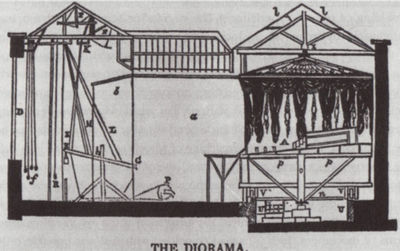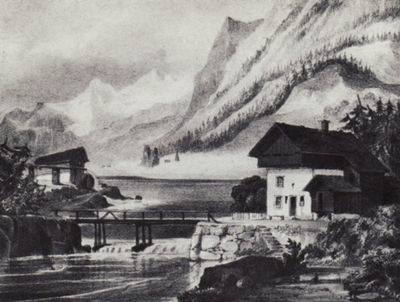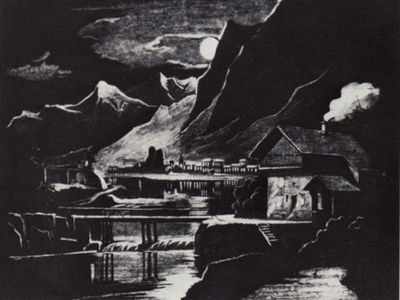Daguerre's Diorama
The diorama was a 19th century light-based medium that featured two immense paintings lit from the front and through the back inside an otherwise pitch-black, rotating auditorium. The diorama combined techniques of opaque and translucent painting with methods of manipulating natural light in a live spectacle.
The diorama was invented by the set designer and painter Louis-Jacques-Mandé Daguerre (together with the architectural painter Charles Marie Bouton) seventeen years before he perfected the daguerreotype process of photography. The daguerreotype would, in the words of Daguerre, "fix the objects reflected in a camera obscura" (Daguerre 78). In contrast to the photographic impulse, the effectiveness of the dioramic image depended on the constant, visible movement of light manipulated with shutters and screens both onto and through a semi-translucent painting. The in-formation of light was thus performed and experienced in real-time, rather than captured and stored for future purpose. Similarly, the spectator expected the illusion "to represent the effects of nature" (Daguerre 84), not to secure "the objective ground of visual truth" (Crary 14) via camera obscura.
Contents
Moving pictures
The diorama, which opened in Paris in 1822, is typically viewed as a proto-cinematic medium. “Culturally and socially it was a kind of forerunner for the cinema,” Helmut and Alison Gernsheim observe in their History of the Diorama (Gernsheim 43). “The only difference,” Wolfgang Schivelbusch argues, “was that the painted picture was replaced by a projected and animated picture” (Schivelbusch 219). However, while photographs would fix light in a single image, and motion pictures would create the impression of continuous movement by showing a sequence of discrete photographs in rapid succession, the moving pictures of the diorama were produced by the manipulation of light waves in real-time. Once the shot is captured, film exists independently of and looks the same regardless of the weather. A storm or a sunny day happens either inside or outside the diegesis. In contrast, the diorama’s moving picture—whether the sun setting through the windows of a cathedral, or a storm gathering behind an alpine peak—was dependent on the influence of the sky: the image required the continuous, variable input of natural light. “The best light for this purpose is a pale sky,” comments Daguerre, though, even with this 'good weather,' “a picture cannot be the same at all hours of the day” (Daguerre 85). On the other hand, because there were always two paintings displayed in a half-hour diorama show (usually one natural and one cathedral scene), despite the analogical source of the illusion, the viewing experience was essentially binary.
Black box matinee
While most lighting technologies were developed in the 19th century to make nighttime as inhabitable as the day, light-based media like the diorama and the panorama gave rise to darkened auditoriums that made daylight exploitable (Schivelbusch 221). Rather than displaying a circular painting lit by a skylight to ambulatory viewers, however, the auditorium of the diorama—a cylinder with a single, window-like opening—was instead rotated mechanically, switching the audience’s view from one painting to the next as its aperture framed the illuminated image.
Lit from a skylight directly above its façade and illuminated from large windows behind, the painting became the object of tunnel vision, with the pitch-blackness of the auditorium funneling the audience’s attention towards the spectacle of light. As the Gernsheims describe, “the spectator’s attention was disturbed by sounds underground,” as the auditorium began to rotate and he or she “became conscious that the scene before him was slowly moving away” (Gernsheim 16). The creaks and rumblings of the medium’s mechanical functionality only temporarily diverted the spectator’s attention, as the second illusion “gradually advanced, until it was completely developed” (16).
The two mechanized components of the diorama operated by workmen—the lever and cogs that turned the auditorium, and the system of shutters and screens controlled by ropes and pulleys behind the painting—were concealed from the audience’s view. “The diorama was a machine of wheels in motion,” Jonathan Crary writes, “one in which the observer was a component” (Crary 113). This comment is telling, because as a component of the machine, the observer was also necessarily concealed. Though the attention of the observer—whose behavior is neatly imagined above by the Gernsheims—was apparently controlled by the effect of tunnel vision, the audience also had to be black-boxed for the (ostensibly mesmerizing) illusion to work. Just as the diorama’s shifting images could not be preserved, its audience, ensconced in the pitch-black core of the artifact, represents a historical blind-spot. A French artifact, the diorama thus provides an interesting exception to Foucault’s "technology of individuals" (qtd. in Crary 15) regulated by surveillance, as well as Debord’s designation of the spectacle as “the sun which never sets over the empire of modern passivity” (Debord 119, emphasis added).
Realism and illusion: the right and wrong sides of the screen
The patent for the first diorama built in London in 1823 describes the device as “an improved Mode of publicly exhibiting Pictures or Painted Scenery of every Description and of distributing or directing the Day Light upon or through them, so as to produce many beautiful Effects of Light and Shade.” As this account indicates, the dioramic picture was both a transparent conduit and an opaque screen, with the effects of light and shade directed both upon and though its substance.
The diorama thus operated according to both catoptric and dioptric principles. As Daguerre describes, “the first effect painted on the right or front of the canvas is lighted by reflection…while the second effect—that painted on the wrong side—receives its light by refraction, that is, from behind only” (Daguerre 83). The right side, facing the spectator, is the realm of the "illusionizing potential of projection, the production of artificial reality" (Zielinski 86). The wrong side belongs to the operator and/or the painter, who performs the catoptric illusion by seeing through it.
On a semiotic level, the "wrong" or dioptric side of the painting was opaque to those who did not possess the knowledge of “dioramic art” (Daguerre 85). Painters schooled in the dioramic technique inscribed the back of the painting with functional nonsense, a language of light and shadow that, in a complete reversal of the painting’s façade, corresponded not the referent of the natural world, but to the forms showing through from the front of the canvas. This secondary inscription would be illegible to the spectator accustomed to representational images. In order to create a heightened illusion of reality, this mode of painting thus broke out of the camera obscura model that relied on a founding referent (Crary 14).
Though, like the mechanically reproduced image, the verso of the dioramic painting was abstracted from a stable, objective referent, the double-sided screen nevertheless divides the complex knowledge of the practitioner of realist illusion from its witness, the spectator. In contrast to the photograph, which, as Walter Benjamin described a century later in his celebration of film, freed the image of the cathedral to “meet the beholder halfway” (Benjamin 220), the image of the cathedral reproduced in the diorama is wrapped not only in the lux of spectacular illusion, but in the aura of an original work authored by a virtuosic artist-scientist.
References
Arrowsmith, John. Diorama Patent, British Patent No. 4899, February 10, 1824. Transcription from http://www.midley.co.uk/.
Benjamin, Walter. Illuminations. New York: Schocken Books, 1968.
Crary, Jonathan. Techniques of the Observer. Cambridge: MIT Press, 1992.
Daguerre, Louis-Jacques-Mandé. An historical and descriptive account of the various processes of the daguerréotype and the diorama. London: McLean & Nutt, 1839.
Debord, Guy. The Society of the Spectacle. Rev. ed. Detroit: Black & Red Books, 1977.
Gernsheim, Helmut and Alison. L.J.M. Daguerre: The History of the Diorama and the Daguerrotype. 2nd Rev. ed. New York: Dover Publications, Inc., 1968.
Schivelbusch, Wolfgang. Disenchanted Night: The Industrialization of Light in the Nineteenth Century. Berkeley: The University of California Press, 1995.
Zielinski, Siegfried. Deep Time of the Media. Cambridge: MIT Press, 2006.




